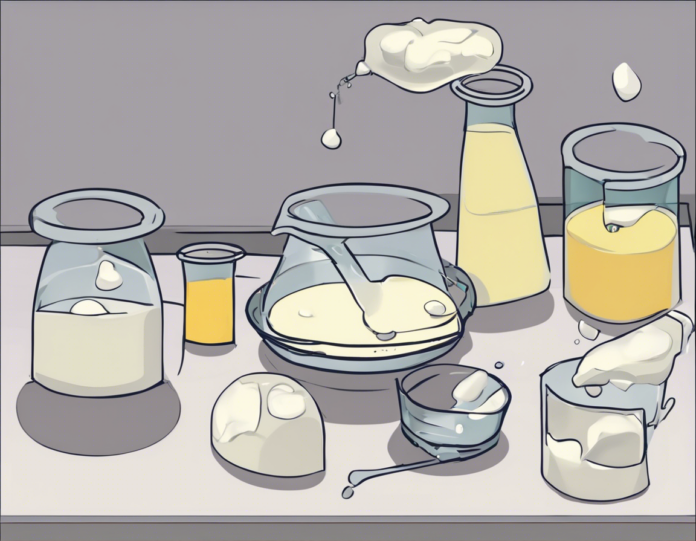When it comes to chemical changes, it can be both fascinating and educational to observe them in action. One common example of a chemical change that can be easily demonstrated at home is the curdling of milk. This process occurs when milk undergoes a series of chemical reactions that cause it to thicken and form curds. In this article, we will delve into the science behind the curdling of milk, explore the factors that influence this process, and discuss how you can conduct your own experiments to observe this transformation firsthand.
Understanding the Curdling Process
What Causes Milk to Curdle?
Milk curdles when its proteins denature and coagulate. The two main types of proteins in milk, casein and whey, are responsible for its white color and nutritional value. When milk is exposed to certain conditions, such as acidic or enzymatic environments, these proteins can undergo structural changes that cause them to clump together, leading to the formation of curds.
The Role of Acids in Milk Curdling
One of the most common ways to curdle milk is by adding an acid, such as lemon juice or vinegar. Acids lower the pH of the milk, disrupting the bonds that hold the protein molecules together. As a result, the protein molecules unfold and bind to each other, forming a solid mass of curds suspended in a liquid whey.
Enzymatic Curdling
Another method of curdling milk involves the use of enzymes, such as rennet. Enzymes work by breaking down specific bonds in the proteins, causing them to aggregate and form curds. This process is commonly used in cheese making, where rennet is added to milk to initiate curd formation.
Factors Influencing Milk Curdling
Temperature
Temperature plays a crucial role in the curdling of milk. Higher temperatures can accelerate the denaturation of proteins and the formation of curds, while lower temperatures may slow down or inhibit the process. For example, heating milk before adding an acid can result in faster curdling.
Type of Acid
Different acids can affect the curdling process in varying ways. Citric acid, for instance, is milder compared to acetic acid (found in vinegar) and may result in a softer curd formation. Experimenting with different types of acids can yield varying textures and flavors in the curdled milk.
Protein Content
The protein content of the milk also influences how it will curdle. Milk with higher protein content, such as whole milk, tends to form larger, denser curds compared to skim milk. This difference in protein content can impact the texture and consistency of the curdled milk.
Conducting Your Own Milk Curdling Experiment
Now that you have a basic understanding of the curdling process, you can conduct your own milk curdling experiment at home. Here’s a simple step-by-step guide to get you started:
Materials Needed:
- Milk (whole or skim)
- Acid (lemon juice, vinegar, etc.)
- Saucepan
- Thermometer
- Stirring utensil
- Cheesecloth (optional)
Instructions:
- Heat the milk in a saucepan over low to medium heat, stirring occasionally to prevent scorching.
- Monitor the temperature of the milk using a thermometer and heat it until it reaches around 180°F (82°C). Heating the milk helps denature the proteins, making them more susceptible to curdling.
- Slowly add the acid of your choice to the hot milk while stirring gently. You should start to see curds forming as the proteins coagulate.
- Continue stirring for a few minutes, then remove the pan from the heat and let it sit for about 15-20 minutes to allow the curds to fully separate from the whey.
- Strain the mixture through a cheesecloth to separate the curds from the whey, if desired.
- Serve and enjoy your freshly curdled milk!
FAQ Section
Q1: Is curdled milk safe to consume?
A: In most cases, curdled milk is safe to consume, although its taste and texture may not be appealing. However, if the milk has an off smell or unusual color, it is best to discard it.
Q2: Can I use any type of milk for curdling experiments?
A: Yes, you can use various types of milk, such as whole, skim, or even plant-based alternatives like almond or soy milk, for curdling experiments. Keep in mind that the protein content and composition may vary, affecting the curdling process.
Q3: Can I reverse the curdling process once it has occurred?
A: Once milk has curdled, the process is irreversible. However, you can experiment with different methods to prevent or slow down curdling, such as adjusting the pH or temperature of the milk.
Q4: What other factors can influence the curdling of milk?
A: Apart from temperature, type of acid, and protein content, factors like stirring techniques, presence of impurities in the milk, and the use of additional ingredients (such as salt or sugar) can also influence the curdling process.
Q5: How can I use curdled milk in cooking or baking?
A: Curdled milk can still be used in cooking or baking by incorporating it into recipes that call for curdled milk, such as certain types of cheese, pancakes, or scones. Experimenting with different recipes can yield interesting and tasty results.
In conclusion, observing the curdling of milk is not only a fun and engaging experiment but also a valuable lesson in understanding chemical changes. By exploring the science behind milk curdling, experimenting with different variables, and conducting your own curdling experiments, you can gain hands-on experience and deepen your knowledge of this intriguing process. So, grab a saucepan, some milk, and an acid of your choice, and start curdling!

